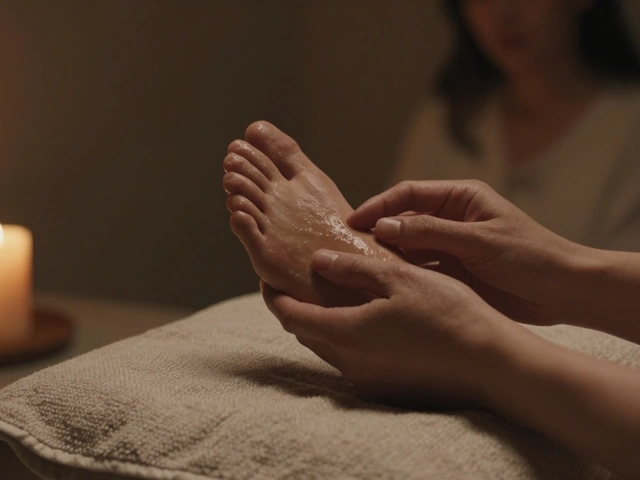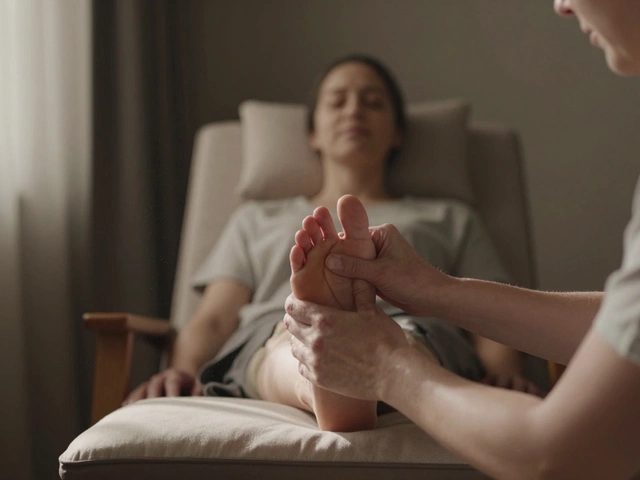Have you ever felt the gentle warmth of a fire and noticed how it calms your mind and relaxes your muscles? Imagine harnessing that sensation for therapeutic purposes. This is the essence of fire massage, a technique that uses heat to enhance physical and psychological well-being. In a world bustling with stress and tension, fire massage offers a unique approach to relaxation and health maintenance.
By carefully applying controlled heat, this therapy helps to expand blood vessels and improve circulation, which in turn can soothe muscle aches and promote healing. Despite its seemingly intense nature, fire massage is a deeply relaxing and rejuvenating experience when performed by a skilled therapist.
- What is Fire Massage?
- Historical Background
- Benefits of Fire Massage
- Practical Applications
- Safety Concerns
- Choosing the Right Therapist
What is Fire Massage?
The term 'fire massage' might evoke images of daring stunts or extreme heat treatments, but in reality, it's a thoroughly researched and carefully applied therapeutic practice. The core principle of fire massage involves the use of heat, generated by lighted materials such as herbs, oils, or alcohol, to create a warm massage experience. Unlike the sharp, searing sensation that the name might suggest, the technique provides a gentle, soothing warmth that penetrates deep into muscle tissues.
This form of therapy is based on the fundamental belief in traditional Chinese medicine that heat can facilitate the flow of Qi (vital energy) throughout the body. By improving Qi circulation, fire massage aims to balance the body’s energy system, which is crucial for maintaining health and fighting diseases. This principle likens the body to a network of rivers and streams, where the smooth flow of water is essential for sustaining the ecosystem.
The treatment typically starts with the therapist preparing the skin with a layer of protective herbal paste or oil to ensure the heat is tolerable and beneficial. A towel or a special material acts as a barrier between the skin and the heat source, which is crucial to prevent burns. The therapist then uses various techniques to move the heat around certain areas, typically focusing on spots that are believed to be centers of energy accumulation, like the back, shoulders, and legs.
Historical Background
The origins of fire massage trace back thousands of years, intertwining its history with various traditional healing practices around the world. This unique form of therapy integrates elements from ancient medicinal knowledge, particularly from Eastern wellness practices. In ancient China and India, healers used fire not only as a source of warmth but as a vital element in the practice of healing the body and mind. These healers believed that fire had properties that could help regulate bodily functions and restore energy balance.
Interestingly, similar practices were independently developed in other regions, including among indigenous tribes in South America and Africa. There, shamans used the heat produced by fire in ritualistic healing ceremonies, asserting it could dispel evil spirits and disease by cleansing the aura of a person. The use of fire in these diverse cultures highlights its universal significance as a potent, purifying element.
In more recent history, the practice evolved to incorporate modern understanding of physical therapy and aromatherapy. Contemporary fire massage, while drawing on its historical roots, often uses tools like fire-heated glass cups or herbal compresses that make the process safer and more controllable. This transformation from purely traditional to a more standardized technique reflects the adaptive nature of fire massage therapy across different eras and cultures.
Benefits of Fire Massage
The allure of fire massage extends far beyond its novel approach; it is revered for tangible health enhancements. This therapy, by harnessing the elemental power of fire combined with traditional massage techniques, leads to profound physical and mental rejuvenation. Key among its benefits is the significant relief it offers from muscle tension. The gentle heat helps to relax the muscle fibers, making them more receptive to therapeutic manipulations, thus deepening the effectiveness of the massage.
Another compelling advantage is the improvement in blood circulation. As heat from the fire massage dilates blood vessels, there's a natural increase in blood flow. This enhanced circulation helps ferry oxygen and nutrients to tired or injured tissues, promoting faster recovery and greater overall cell health. For those suffering from chronic pain conditions like arthritis or fibromyalgia, this can be a welcomed relief, delivering nutrient-rich blood to areas starved by inflammation.
Stress reduction is another cornerstone of fire massage's appeal. The warmth combined with massage provides a double dose of relaxation, engaging the body’s parasympathetic nervous system—responsible for restoring the body to a state of calm. Many find fire massage to be a sanctuary where the pressing concerns of the day melt away, replaced by a focus on the present moment and physical well-being.
Moreover, the skin, the body’s largest organ, also reaps benefits from this treatment. The heat encourages the pores to open, allowing for better absorption of massage oils which can be infused with therapeutic herbs and essences. This not only enhances the skin’s softness and elasticity but also supports the detoxification processes. Regular sessions can lead to noticeable improvements in skin texture and tone.
Immune system boosting is another lesser-known but crucial benefit. The improvement in circulation and stress reduction naturally enhances the body's defense mechanisms. A healthier circulation means toxins are cycled out more efficiently, and a reduction in stress hormones like cortisol supports a stronger immune response.
Practical Applications
The application of fire massage spans various scenarios, each tailored to enhance therapeutic benefits specifically suited to individual needs. Among the most common setups are spas and wellness centers, where fire massage is offered as a premium service for relaxation and stress relief. Clients lie on a comfortable massage table, and the therapist begins by applying a protective layer of a special gel or herbal paste to the area to be treated. This layer acts as a barrier and also provides essential nutrients to the skin.
Once the protective layer is in place, the therapist lights a small, controlled flame and uses it to heat a set of specialized tools, typically made of glass or ceramic. These heated tools are then skillfully glided over the gel-covered skin. The heat is not just superficial; it penetrates deeply into the muscle tissues, promoting enhanced blood flow, reducing muscle stiffness, and flushing out toxins through the skin. This practice can be particularly beneficial for those recovering from physical injuries as it accelerates the healing process and relieves pain.
Additionally, fire massage can be applied in the comfort of one's home, although this requires careful consideration and adherence to safety protocols to prevent any risks. It is essential to have a professional therapist conduct the session or thoroughly train the individuals involved to ensure safe and effective application. The at-home version of fire massage often focuses on treating smaller, more localized areas like the back or shoulders, where stress and tension are commonly held.
The alteration of traditional massage techniques with the incorporation of fire intuits a transformative experience for the body and mind. The warmth of the fire not only relaxes tight muscles but also stimulates endorphin release, creating an overall sense of well-being and relaxation. Because of these versatile applications, fire massage has been warmly embraced in holistic health communities and continues to grow in popularity amongst those seeking natural remedies for chronic stress and physical discomfort.
Safety Concerns
When it comes to unconventional therapies like fire massage, an emphasis on safety cannot be overstated. Intriguing and beneficial as it may be, fire massage involves elements that can pose risks if not managed correctly. The primary components of this therapy include the use of heat, controlled flames, and sometimes even essential oils, which can be flammable. A well-trained therapist is crucial, as they need to understand the intricacies of temperature control and skin protection to prevent burns and other injuries.
The procedure usually starts with the therapist applying a protective layer, such as a thick towel or a special herbal paste, to shield the skin from direct contact with heat. This step is crucial for avoiding thermal damage. The quality and suitability of these protective materials are therefore a significant concern. It's important to inquire about the materials used and ensure they are safe for high-temperature exposure. Not all fabrics or materials are suitable, and using the wrong type can lead to safety hazards.
Training and certification of therapists also play a vital role in the safety of fire massage. Due to the risks involved, it’s essential for practitioners to have undergone extensive training and to hold certifications in fire massage therapy. These qualifications are not just about learning how to handle fire safely; they also involve understanding of skin types, possible allergic reactions, and emergency procedures in the unlikely event that something does go wrong.
Another significant aspect to consider is the setting in which the fire massage is performed. The room must be well-ventilated to avoid the buildup of fumes from any essential oils or burning materials. It should also be equipped with the appropriate fire extinguishing equipment, ensuring that any fire-related emergency can be handled swiftly and efficiently. Regular safety drills and inspections can also enhance safety by ensuring that both therapist and facility are prepared for any incidents.
For those interested in experiencing fire massage, conducting a thorough vetting of the therapist's credentials and the safety measures at the facility is advised. Potential clients should feel free to ask about the therapist’s training, experience, and emergency preparedness. Ensuring personal comfort with these elements before proceeding with such a therapy is not just advisable; it's essential.
Finally, while the risk of severe injury is generally low when fire massage is performed correctly, it is always prudent for individuals to discuss any skin conditions or health concerns with their therapist before undergoing the treatment. This allows the therapist to tailor the session to the client’s specific health needs and ensure the utmost safety and effectiveness of the treatment.
Choosing the Right Therapist
Selecting the right therapist is crucial when considering fire massage therapy. It's not just about finding someone who can perform the technique, but ensuring they have a deep understanding of the safety protocols, a thorough knowledge of the human body, and a sensitive approach to individual needs. A certified practitioner who specializes in fire therapy should have not only credentials but also positive testimonials from previous clients that reflect their skill and professionalism. The right therapist will make you feel at ease, ensuring that the session enhances both your physical and mental well-being.
When searching for a suitable therapist, it's important to consider their training and experience. Reputable therapists will have undergone specialized training in fire massage and will be up to date with the latest safety standards and techniques. They should openly share information about their certifications and training upon request. Always check for any professional affiliations they might have with recognized bodies in the field of alternative therapies or massage therapy. This provides an additional layer of trust and assurance in their qualifications.
An insightful way to gauge a therapist's expertise is to ask about their approach to dealing with sensitive or high-risk clients, such as those with certain skin conditions or a history of cardiovascular problems. This not only shows their level of technical knowledge but also their capacity for empathy and individualized care. A skilled fire massage therapist will be keen on discussing your health history, your current health condition, and any concerns you might have prior to beginning a session.
Another vital factor is the therapist’s ability to create a relaxing environment. They should have a well-maintained, hygienic workspace that promotes relaxation. Soft lighting, gentle music, and a clean aroma are key elements that help in setting a calming mood, which can significantly enhance the effectiveness of fire massage therapy. Ensure that safety measures like fire extinguishers and first aid kits are visibly present, showcasing that the therapist prioritizes client safety above everything else.
Finally, consider the feedback from previous clients. Online reviews, testimonials on their website, or recommendations through word of mouth can provide insights into the therapist’s reliability and the quality of their service. Happy clients usually leave detailed reviews about their experience, which can be a good indicator of what to expect. Remember, a good therapist not only provides effective treatment but also builds a relationship of trust and safety with their clients, which is paramount in any therapeutic setting.








